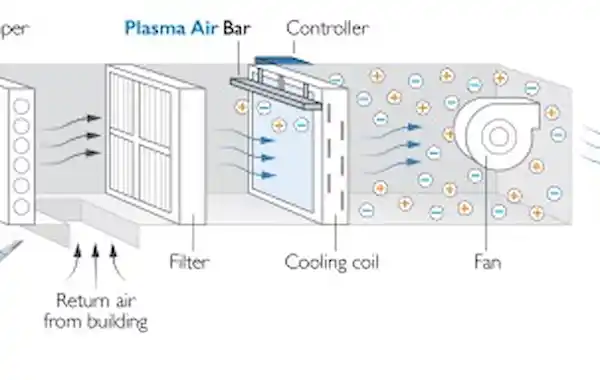06 May 2021
|

It’s been just over a year since the restrictions related to coronavirus were first put into place, during which, there has been a lot of guidance for how to operate buildings safely. Adam Taylor, chief innovation officer of indoor air quality certification provider AirRated, reviews which of these methods are most likely to be applied.
It’s no secret that proper ventilation has been key to reducing the transmission of the coronavirus. However, since the beginning of the pandemic, following the advice from government and industry bodies has been challenging.
The initial guidance was to open windows, then to make use of high efficiency particulate air filters (HEPA) and ultraviolet light systems. Both of which are promoted by The American Society of Heating, Refrigerating and Air Conditioning Engineers (ASHRAE), The Chartered Institution of Building Services Engineers (CIBSE) and Scientific Advisory Group for Emergencies (SAGE). Turning off thermal wheels in heat recovery ventilation was also advised early on in the pandemic.
All of this advice is, of course, scientifically valid. But there’s a gap between what’s advised and what’s possible. These solutions are just not easily deployable for the majority of businesses and people.
The challenges of doing the simple things
Sometimes things aren’t as simple as they sound. In the UK, for example, it’s not that easy to just tell people to open the windows to ventilate their homes. There’s a pervasive concern in this country about saving energy or ‘not letting the heat out’. The fact is, windows only need to be slightly opened to significantly improve indoor air quality and, in doing so, not affecting the overall temperature of the space. The interplay of advice is confusing, and when confused, people will revert to the thing they’ve been told the most and for the longest: keep the heat inside the house.
More to the point, in many of our office buildings, the windows simply cannot be opened. Since the 1970s, buildings have been built to be more and more energy efficient, so many of us work in hermetically sealed boxes. Yes, it’s more economical and environmentally friendly, but the old ‘open the windows’ line just doesn’t apply here.
Mechanical ventilation: not always an easy fix
I hate to state the obvious, but it seemingly bears repeating - you can’t just increase the ventilation rate on some buildings. There are other things to consider, such as the amount of noise that brings, energy usage, and whether you can heat that building in doing so. There’s also the issue that in many parts of the country, the fresh air that would be brought in isn’t that fresh at all.
HEPA filters
Using HEPA filters to remove particles is excellent for general health benefits. Still, there is little evidence that the virus is spread through centralised heating, ventilation and air conditioning systems, so they’re not the best option for the situation we’re in.
Furthermore, you can’t simply take an existing ventilation system and upgrade it to a HEPA filter. The system is unlikely to cope with the increased pressure drop, so it brings in less air and therefore increases the risk of transmission.
Thermal wheels
The knee-jerk reaction from many sources was to turn off the thermal wheels installed in the energy recovery ventilation plant. This advice was fine when first issued in mid-spring, but when applying to the United Kingdom, there’s only a tiny window of time when this is a viable option.
With thermal wheels turned off, cooling systems had to work harder in the summer, and heating systems could not cope in the winter. Fortunately, this didn’t present a significant comfort issue as buildings were largely unoccupied.
Very soon, however, people will start returning to work en masse, but we still won’t be out of the woods with the coronavirus. Ventilation will always be essential, and if thermal wheels remain switched off as advised, the heating and cooling systems will have to perform outside of their design parameters to deal with the loads.
Ultraviolet systems
UV systems do have good pass-through kill rates for pathogens, but they also require a lot of energy and heavy modifications to the HVAC system.
The vast majority of UK buildings don’t even have centralised recirculating HVAC systems, so UV treatment is neither appropriate nor necessary in these instances.
UV fitted in recirculation systems is not seeing mass-deployment as the systems use too much energy and take up too much space.
So why were these solutions offered if there are so many issues? Part of the reason that advice regarding UV and HEPA filters came out relatively quickly is that it’s easy to test UV exposure and HEPA filters' effectiveness on a small scale and then extrapolate that to working environments. But clearly, that doesn’t mean they’re the right solution for every application.
So what can we do?
Naturally, the first thing people do is follow the issued advice, especially if they’re responsible for reducing risk in a business. But if they try to do this and find they can’t, for whatever reason – too expensive, too uncomfortable, completely impossible – of course, the next step is to go looking for other solutions, and luckily, there are plenty of deployable options to consider.
Find solutions that are active in the space
Despite early fears, there isn’t much evidence of significant super-spreader events linked to centralised HVAC systems. For that reason, if you want to reduce risk, deploying systems fitted in the air handling unit isn’t the most appropriate option. Instead, you’re better off deploying solutions that are active in the space.
Let’s recap pass-through technologies: with these, you have to wait for air from the room to be brought back to the air cleaner. This means that you are reliant on air changes per hour. Moving large volumes of air around not only uses a lot of energy but also increases noise.
When it comes to UV systems fitted to recirculating HVAC systems, for example, they are reliant on having sufficient dwell time, which is not always feasible due to size limitations.
A better option is germicidal technologies active in the space, such as upper room ultraviolet systems and bipolar ionisation. In addition to reducing risk from airborne pathogens, the latter improves a range of indoor air quality parameters, further increasing its attractiveness as a solution. However, it should be noted that it needs careful integration with the HVAC system to work effectively.
With these germicidal technologies, there’s no need to wait for the air stream to enter the air cleaner, as the reaction with in-room contaminants starts to happen almost instantaneously. In reality, these are the type of systems that are eventually seeing adoption after duct-mounted HVAC and HEPA have been investigated and found to be impractical.
Energy usage
Extensive use of air cleaning technologies came about because of the oil crisis. Previously, there hadn’t been much consideration, but as oil became more expensive, people became increasingly concerned about energy expenditure.
Take a UV system in a fan coil unit, for example. There are great results of it destroying the virus, but it undoubtedly uses a lot of energy: in fact, the UV system required to be effective on a single pass would use 150-200 watts. By comparison, a bipolar ionisation system uses less than 1watt.
Things are the same but different now, people are still concerned about energy usage, but where previously it was all about money, now it’s about our planet.
What we need is sustainable, long-term solutions
It’s easy to suggest the solutions advised in the early days of the pandemic, because in theory, they make sense, and they will work very well – in a lab. How applicable these solutions are to our average UK HVAC system is where the challenge lies. Moreover, if this disease becomes endemic, we will have to deal with it regularly.
Long-term solutions need to be deployed because it is clear that these short-term solutions that reduce the risk immediately aren’t sustainable. We must find appropriate solutions that don’t cost the earth (pun intended).








